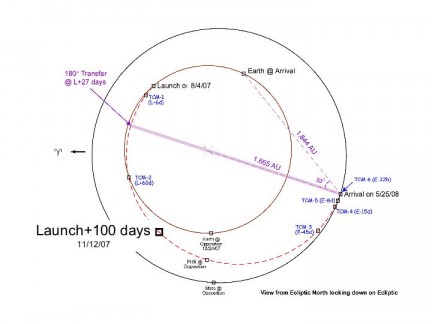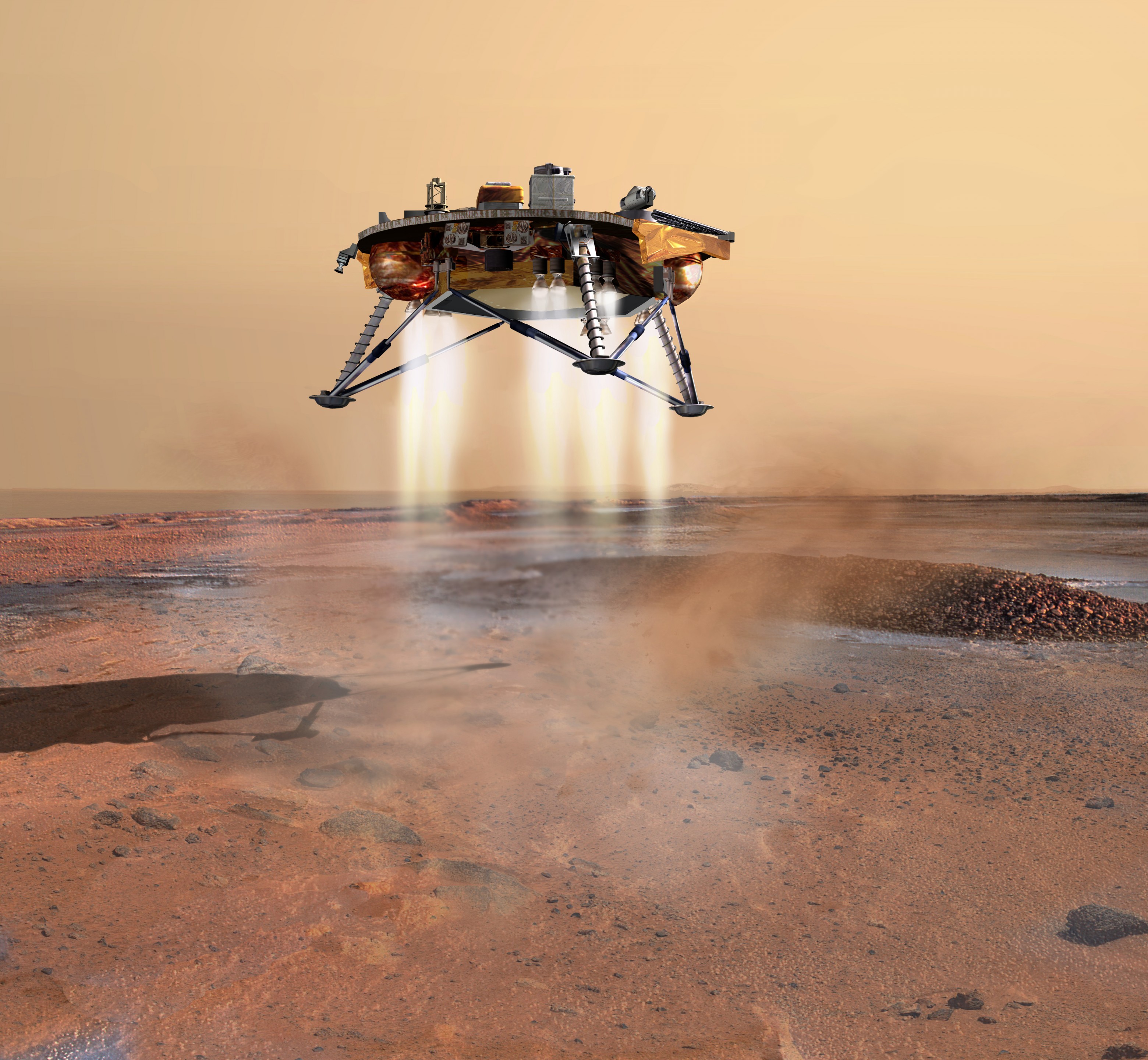Looking towards a May 25 landing for the Phoenix Mars Lander, the navigation team for mission adjusted the flight path for the spacecraft on April 10. “This is our first trajectory maneuver targeting a specific location in the northern polar region of Mars,” said Brian Portock, chief of the Phoenix navigation team at the Jet Propulsion Laboratory. The mission’s two prior trajectory maneuvers, made last August and October, put the spacecraft on target to just intersect with Mars. But this recent maneuver put it on course to land at a site called “Green Valley,†a broad, flat valley in Mars north polar region. NASA announced they have “conditionally” approved this site, but a final decision has yet to be made. And why, you ask, hasn’t a final decision been made on a landing site at this late date?
Phoenix mission managers are still looking for a safe, yet exciting place to land. The proposed landing area is an ellipse about 62 miles by about 12 miles (100 kilometers by 20 kilometers). In looking at high resolution images of this area, researchers have mapped more than five million rocks in and around that ellipse, each big enough to end the mission if hit by the spacecraft during landing. “The environmental risks at landing — rocks and slopes — represent the most significant threat to a successful mission. There’s always a chance that we’ll roll snake eyes, but we have identified an area that is very flat and relatively free of large boulders,” said JPL’s David Spencer, Phoenix deputy project manager and co-chair of the landing site working group.
MRO’s High Resolution Imaging Science Experiment (HiRISE) camera has taken more than three dozen images of the area. Analysis of those images prompted the Phoenix team to shift the center of the landing target 13 kilometers (8 miles) southeastward, away from slightly rockier patches to the northwest. Navigators used that new center for planning the recent trajectory correction maneuver.
“Our landing area has the largest concentration of ice on Mars outside of the polar caps. If you want to search for a habitable zone in the arctic permafrost, then this is the place to go,” said Peter Smith, principal investigator for the mission, at the University of Arizona , Tucson .
When Phoenix lands, it will dig to an ice-rich layer expected to lie within arm’s reach of the surface. It will analyze the water and soil for evidence about climate cycles and investigate whether the environment there has been favorable for microbial life.

The April 10 trajectory adjustment began by pivoting Phoenix 145 degrees to orient and then fire spacecraft thrusters for about 35 seconds, then pivoting Phoenix back to point its main antenna toward Earth. The mission has three more planned opportunities for maneuvers before May 25 to further refine the trajectory for a safe landing at the desired location.
In the final seven minutes of its flight on May 25, Phoenix must perform a challenging series of actions to safely decelerate from nearly 21,000 kilometers per hour (13,000 mph). The spacecraft will release a parachute and then use pulse thrusters at approximately 914 meters (3,000 feet) from the surface to slow to about 8 kilometers per hour (5 mph) and land on three legs.
For more information about Phoenix , visit NASA’s site, and ASU’s site


I’ve got to wonder how many of the scientists don’t think that they will actually discover life when this thing lands.
If I were a scientist on the project who thought that, I would be implementing a lesson learned from Viking and manage the public expectation by saying “we just going to see if once upon a time there ever was life that could have lived here.
Woulden’t that be fantastic is it found life!
I still do not have a clue why all these years we sent probes to where there was no real indicators for water looking for water, hence the possibility of life, when in fact it was known that there was water ice at the poles
and we just now decide to check there??
I guess I am just a dumb lay person..
It’s sad to have such an overwhelming lack of interest of the public in an event that might be truely historic. Prior to 1962, Earl C. Slipher and the other astronomers of the era all saw the band of dark blue hug the polar cap of Mars as it retreated. This was interpreted as a sign of life – that Phoenix might find. We wrote about it “Imminent Discovery”. Won’t NASA be surprised if the early astronomers were right….
Web site for comment above – if interested….
Here is something I have always wondered about this mission. When Phoenix lands isn’t the hot, probably toxic exhaust from the landing rockets going to contaminate the very surface that is going to be sampled?
Life is the paradigm of the universe.
i hope they find intelligence on mars, judging by the above posts theres f-all here
What are the odds for a probe to find water in Sahara? Yet we know that there are underground water reservoirs and oases full of life. This is just a hypothetical question and is meant to remind the huge difficulty in this mission. Still I think it’s worth-while. You never know when you beat the odds!
# paul Says:
April 13th, 2008 at 6:03 am
“i hope they find intelligence on mars, judging by the above posts theres f-all here”
Coming from a guy who fails to capitalise the letter ‘i’ not only as it is used in reference to the first person, but also at the start of a sentence, and can’t remember that sentences are terminated with a full stop.
Yeah – your post really raised the bar, moron. Try learning the English language at the first-grade level before you go using it to call other people unintelligent.
Will I get to see more pictures of the landing?